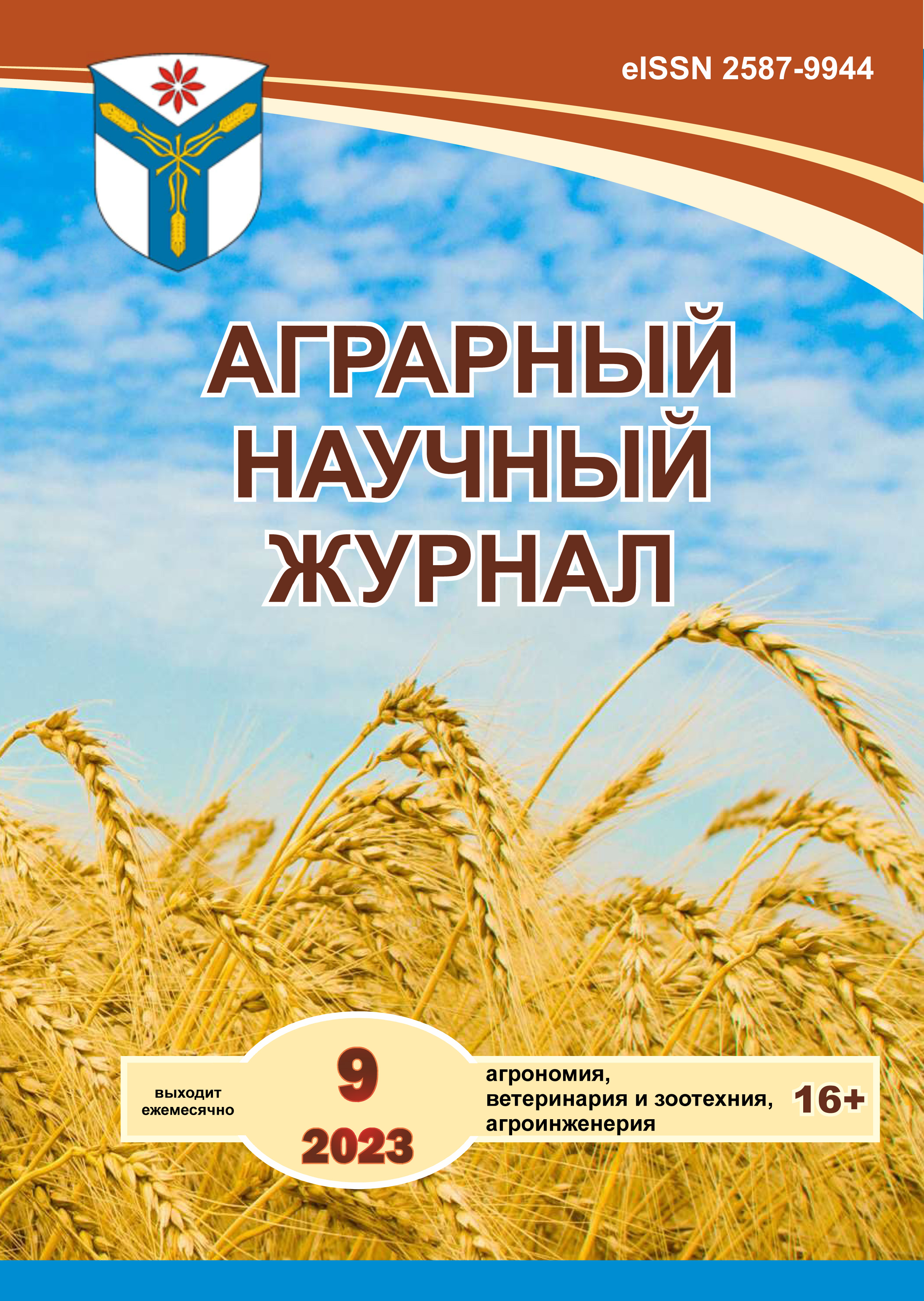Openly living phytophages and entomophages of the agrocenosis of winter soft wheat in the forest-steppe of the Samara region
DOI:
https://doi.org/10.28983/asj.y2023i9pp59-65Keywords:
winter wheat, phytophages, agrocenosis, species composition, squads, familiesAbstract
Studies were conducted to study the species composition of open-living insects of phytophages and entomophages in the agrocenosis of winter soft wheat on varieties Povolzhskaya 30 and Povolzhskayaniva. The studies were conducted in 2020-2022, which differed in meteorological conditions, in the forest-steppe zone of the Samara region. In the agrocenosis of winter wheat, 28 species of phytophagous insects were identified, which belonged to 16 families. The most numerous in terms of species composition were the families: Chloropidae, Chrysomelidae ,Aphididae, Scutelleridae. The families were small in species composition: Phlaeothripidae, Pentatomidae, Berytidae, Miridae, Acrididae, Elateridae, Cephidae, Carabidae and Scarabaeidae. All phytophagous insects were divided into 6 orders: Bubble-legged or Thrips (Thysanoptera), Hemiptera or bugs (Hemiptera), Diptera (Diptera), Coleoptera or Beetles (Coleoptera), Straight-winged (Ortoptera), Hymenoptera (Hymenoptera). Numerous species composition of phytophagous insects was observed in the orders of Hemiptera (39.0%), Diptera and Coleoptera (25.0% each). The majority of phytophagous insects fed only on vegetative parts of plants (64.0%) (roots, stems, and leaves), 7.0% of species fed on generative parts of plants (mainly grain feeding). 29.0% of the species had a mixed type of nutrition, on vegetative organs (mainly in the larval stage) and on generative organs (mainly imago). Among phytophagous insects, the proportion with a gnawing mouth was 54.0%, and the proportion with a sucking mouth was 46.0%. The species composition of openly living entomophages in the agrocenosis of winter wheat was diverse. It is represented by 6 detachments. The largest number of species was observed in the orders Coleoptera or Beetles (Coleoptera) and the order of Spiders (Araneae). Ladybugs (Coccinellids) dominated among entomophages, which were represented by 9 species.
Downloads
References
Взаимодействие культурных растений и вредных объектов в агрофитоценозах / Ю. Я. Спиридонов [и др.] // Аграрный научный журнал. 2018. №7. С. 26–30. DOI: 10.28983/asj.v0i7.525.
Глазунова Н.Н. Оптимизированная система защиты озимой пшеницы //Защита и карантин растений. 2019. № 12. С. 16–19.
Глазунова Н.Н., Безгина Ю.А., Мазницина Л.В., Хомутова А.В. Биологическая эффективность защиты озимой пшеницы от фитофагов биопестицидами в весенне-летний период вегетации// Политематический сетевой электронный журнал Кубанского государственного аграрного университета. 2020. №155. С. 220–229.DOI: 10.21515/1990-4665-155-017.
Каплин В.Г. Мониторинг энтомокомплексов мягкой озимой пшеницы в лесостепи Самарской области // Известия Самарской государственной сельскохозяйственной академии. 2016. №3. С.10–15. DOI: 10.12737/20327.
Каплин В.Г. Мониторинг энтомокомплексов мягкой яровой пшеницы в лесостепи Самарской области // Известия Самарской государственной сельскохозяйственной академии. 2016. № 4. С. 3–9. DOI: 10.12737/21794.
Наас Х. А., Хамза Х. М., Присный А. В. Насекомые вредители пшеницы в Белгородской области (Россия)//Научные ведомости Белгородского государственного университета. Серия: Естественные науки. 2014. № 23(194). С. 70–75.
Саченков А. В., Емельянов Н. А. Вредоносность доминантных фитофагов на семенных посевах яровой пшеницы и организация ее защиты// Достижения науки и техники АПК. 2016. №1. С. 26–30.
Прогноз фитосанитарного состояния агроценозов Украины в условиях изменяющегося климата / В. П. Федоренко [и др.] // Защита и карантин растений. 2008. №7. С.30–32.
Хилевский В.А. Основные вредители озимой пшеницы в степной зоне Предкавказья// Символ Науки: Международный научный журнал. 2015. № 9-2. С. 42–45.
Шарапов И.И., Шарапова Ю.А. Влияние ярутки полевой (Thlaspiarvense) на основные элементы продуктивности озимой пшеницы// Международный журнал гуманитарных и естественных наук. 2018. №11-2. С. 89–91. DOI: 10.24411/2500-1000-2018-10200.
Шарапов И.И., Шарапова Ю.А., Влияние конопли сорной на элементы продуктивности и поврежденность зерна пшеничным трипсом и хлебными клопами в агроценозе озимой мягкой пшеницы// Аграрный научный журнал. 2021. № 9. С. 50–54.DOI: 10.28983/asj.y2021i9pp50-54.
Эколого-биологические взаимодействия грибов рода Fusarium и фитофагов злаковых культур / Е. А. Степанчева[и др.] // Евразийский энтомологический журнал. 2016. № 6. С. 530–537.
Kaplin V.G., Sharapova Y.A. Influence of the russian wheat aphid diuraphis noxia (Kurdjumov) (Homoptera, Aphididae) on productive qualities of spring bread wheat and barley grown from the seeds from aphid-infested spikes// Entomological review. 2017. No. 4. P. 415–424. DOI:10.1134/S0013873817040030.
Singh B., Kular J. S. Notes on the Bionomics of the Pink Stem Borer Sesamiainferens Walker (Lepidoptera: Noctuidae): An Upcoming Pest of Wheat in India//ActaPhytopathologicaetEntomologicaHungarica. 2015. No. 50(2). Р. 239–259. DOI: 10.1556/038.50.2015.2.9.
Wheat Breeding for Resistance to Major Insect Pests / T.Wuletawet al. // Agricultural Research& Technology: Open Access Jornal. 2021.Vol. 25 No. 5.Р. 1–11.DOI: 10.19080/ARTOAJ.2021.25.556321.
Downloads
Published
Issue
Section
License
Copyright (c) 2023 The Agrarian Scientific Journal

This work is licensed under a Creative Commons Attribution-NonCommercial-NoDerivatives 4.0 International License.








